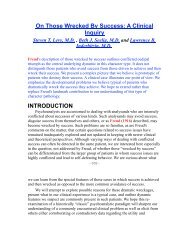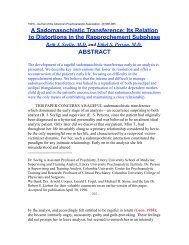The Rape of Medusa - Beth J. Seelig, MD
The Rape of Medusa - Beth J. Seelig, MD
The Rape of Medusa - Beth J. Seelig, MD
Create successful ePaper yourself
Turn your PDF publications into a flip-book with our unique Google optimized e-Paper software.
Freud found the subject <strong>of</strong> female psychology puzzling. He stated, ‘in general<br />
our insight into these developmental processes is unsatisfactory, incomplete and<br />
vague’. (1924, p. 179). In his famous exasperated plea to Princess Marie<br />
Bonaparte, he asked, ‘What does a woman want?’ (quoted in Jones, 1953, p. 421).<br />
Richards (1999) has reminded us that he listened to and respected his female<br />
colleagues and was a strong advocate <strong>of</strong> equality for women. However, as Fliegel<br />
(1973) described, when he felt that his cherished psychoanalytic theories were<br />
under direct attack by his erstwhile followers Jones (1927) and Horney (1926,<br />
1933), particularly in the area <strong>of</strong> female psychosexual development, he defended<br />
his formulations vigorously, even going so far as to categorically deny the<br />
existence <strong>of</strong> vaginal sensations in the little girl (Freud, 1933, p. 118), recognised<br />
by Klein (1932).<br />
Considering it inevitable for a young girl to feel castrated when she learned<br />
about the genital difference between males and females, Freud regarded penis<br />
envy as the psychological bedrock <strong>of</strong> the female. This theory, in combination with<br />
his ideas about the relative weakness <strong>of</strong> the female superego (Freud, 1925, 1931,<br />
1933), led to the unfortunate consequence that Freud's theories were globally<br />
denounced and subsequently disregarded by many feminist authors.<br />
In his recent paper on female subjectivity H<strong>of</strong>fman attributes the root <strong>of</strong><br />
Freud's problem in understanding women to the fact that ‘Freud's philosophic and<br />
intellectual roots include the assumption that subjectivity is to be considered<br />
possible only for men’ (1996, p. 24). As Dimen stated, ‘Freud's anatomical map <strong>of</strong><br />
a brave new sexual world plots a passage that begins as though generic to Homo<br />
sapiens but ends in masculinity: in a failure <strong>of</strong> nerve, it inscribes things female on<br />
a “dark continent”’ (1997, p. 528).<br />
Orgel wrote about Freud's conviction that all males must repudiate the<br />
feminine. Unable to accept his own feminine and maternal identifications,<br />
he would not gaze upon his mother in her c<strong>of</strong>fin. He sent Anna to his<br />
mother's funeral. Anna, his female self, his Athena-Antigone, would be<br />
his eyes. She could bear to look and take his mother in—for him, as him<br />
(Orgel, 1996, p. 46).<br />
Freud's difficulties with femininity and female sexuality formed a strong<br />
precedent for generations <strong>of</strong> subsequent psychoanalysts. His formulations about<br />
women seemed to be clinically confirmed in the analyses <strong>of</strong> many women. It was<br />
difficult to get beyond the idea <strong>of</strong> ‘bedrock’ for many who respected his authority<br />
and may have suffered from similar unexamined areas <strong>of</strong> countertransference<br />
blindness in the area <strong>of</strong> female psychosexual development. Gradually, however,<br />
alternative formulations have gained recognition and female development is<br />
recognised as separate and quite distinct from male development, rather than being<br />
regarded as a variant on the male norm.




